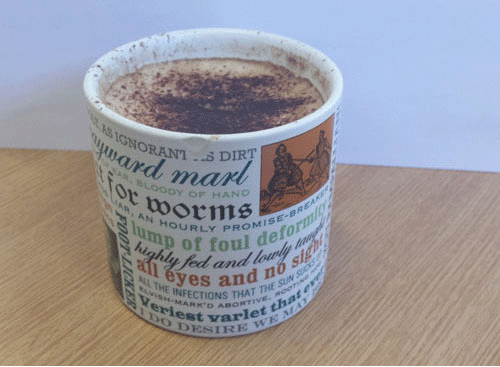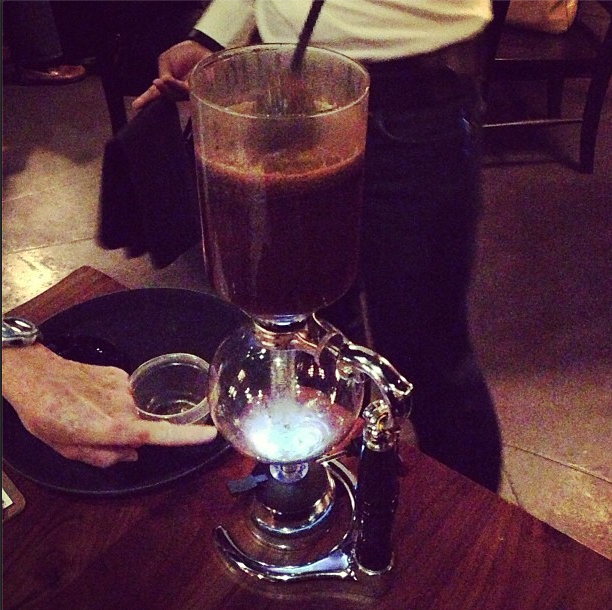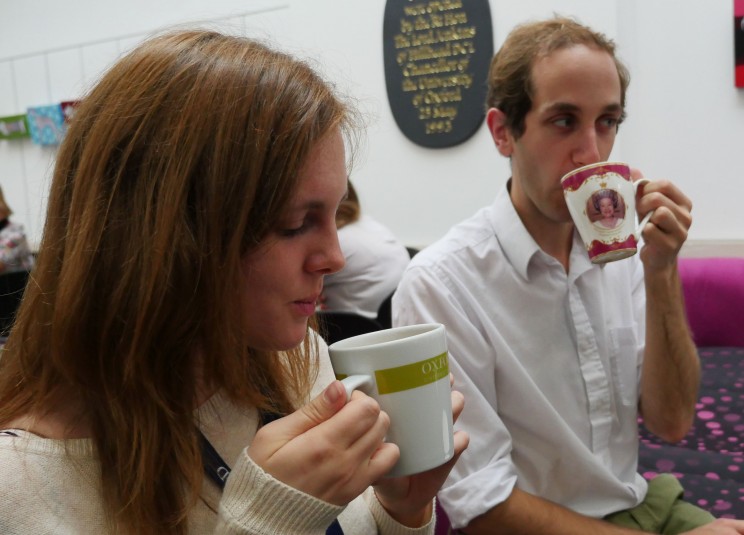new posts in all blogs
Viewing: Blog Posts Tagged with: alice northover, Most Recent at Top [Help]
Results 1 - 13 of 13
How to use this Page
You are viewing the most recent posts tagged with the words: alice northover in the JacketFlap blog reader. What is a tag? Think of a tag as a keyword or category label. Tags can both help you find posts on JacketFlap.com as well as provide an easy way for you to "remember" and classify posts for later recall. Try adding a tag yourself by clicking "Add a tag" below a post's header. Scroll down through the list of Recent Posts in the left column and click on a post title that sounds interesting. You can view all posts from a specific blog by clicking the Blog name in the right column, or you can click a 'More Posts from this Blog' link in any individual post.
Word of the Year season has closed with the selections of the American Dialect Society this past weekend, so it's time to reflect on the different words of the 2015. The refugee crisis and gender politics have featured prominently in selections around the globe as well as the influence of technology.
The post Words of 2015 round-up appeared first on OUPblog.
On Tuesday, we shared our editors' selections of the best of OUPblog publishing this year, and now it's time to examine another measure: popularity, or in our case, pageviews. Our most read blog posts of 2015 are... not published in 2015. Once again, Galileo, Cleopatra, antibiotics, and quantum theory (all published in previous years) have dominated our traffic.
The post Top ten OUPblog posts of 2015 by the numbers appeared first on OUPblog.
The publishing volume of the OUPblog has finally led to the inevitable -- I can no longer read every article we publish. Fortunately, I have an amazing team of deputy editors who review articles, catch (most) errors, and discover the best of our publishing over the course of the year.
The post Top OUPblog posts of 2015: Editor’s Picks appeared first on OUPblog.
I had a rather unexpected start for the OUPblog. I spent my first day getting to grips with all the customizations and plugins of the blogging platform. I was armed with quite possibly the most amazing exit memo ever written (thank you Lauren). I was fully confident that a smooth transition was underway.
The post “a rather unexpected start”: Alice Northover on the OUPblog appeared first on OUPblog.
Yesterday we shared 34 selections of the OUPblog's best work as judged by sharp editorial eyes and author favorites. However, only one of those selections coincides with the most popular posts according to pageviews. Does Google Analytics know something that our editors do not? Do these articles simply "pop" (and promptly deflate)? Or are there certain questions to which people always demand an answer?
The post The 34 most popular OUPblog posts of the last ten years appeared first on OUPblog.
Wednesday, 22 July 2015, marks the tenth anniversary of the OUPblog. In one decade our authors, staff, and friends have contributed over 8,000 blog posts, from articles and opinion pieces to Q&As in writing and on video, from quizzes and polls to podcasts and playlists, from infographics and slideshows to maps and timelines. Anatoly Liberman alone has written over 490 articles on etymology. Sorting through the finest writing and the most intriguing topics over the years seems a rather impossible task.
The post The best of a decade on the OUPblog appeared first on OUPblog.
Word of the Year season closed this weekend with the annual meeting of the American Dialect Society. As usual, major news stories dominated selections, but there has been a notable uptick in social media-related choices. It is interesting to note how hashtags are becoming more prevalent with #IndyRef as a common runner-up, and #dirtypolitics and #blacklivesmatter winning the title.

In the English-speaking world:
- Oxford Dictionaries selected ‘vape’, an abbreviation of vapour or vaporize, given its increase usage with the rise in electronic cigarettes.
- Merriam Webster selected ‘culture’, based on an increase in look-ups.
- Collins selected ‘photobomb’, made famous by monkeys and celebrities.
- The Australian National Dictionary Center (ANDC) selected ‘shirtfront’, meaning ‘in figurative use, to challenge or confront a person’.
- Dictionary.com selected ‘exposure’, noting its relationships to major news stories this year surrounding Ebola, hacking, and Ferguson.
- Cambridge Dictionaries noted several words that demonstrated a surge in look-ups including ‘devolution’, ‘cleavage’, and ‘asphyxiate’.
- Chambers Dictionary selected ‘overshare’: “beautifully British” with “a hint of understatement”.
- Geoff Nunberg selected ‘God View’, the term which Uber uses for their internal map of cars and customers.
- Ben Schott at The Takeaway listed several of the worst words of 2014.
- Dennis Baron selected ‘torture’: “it’s the epitome of what went wrong, not just with counterterrorism, but with everything.” He has already selected ‘autocorrect’ as 2015’s Word of the Year.
- Grant Barrett noted several buzzwords of 2014, including ‘basic’, ‘columbusing’, and ‘flee’.
- Gretchen McCulloch at Slate’s Lexicon Valley made an argument for emoticon of the year.
- And in a related note, Global Language Monitor selected the heart-shaped emoji.
- Public Address (of New Zealand) selected #dirtypolitics.
- National Commission for Culture and the Arts (NCCA) of the Philippines selected ‘selfie’ of Word of the Year, chosen among the 13 words submitted during the Sawikaan 2014.
- Nancy Friedman selected ‘Ebola’ (and see her full list of ADS submissions and notable words).
- Ben Zimmer spoke to NPR about some finalists, including ‘die-in’ and ‘platisher’.
- Lynne Murphy selected four UK-to-US and US-to-UK words of the year: ‘gap year’, ‘dodgy’, ‘bake-off’, and ‘awesome’.
- Grammar Girl selected ‘adulting’.
- Hugo used Twitter bots to find some of the top words of 2014.
- Wordnik has a list of 2014 nominations.
- Lake Superior State University released their annual ‘banishment’ list, including ‘bae’, ‘polar vortex’, ‘hack’, ‘skill set’, and ‘swag’.
- Wordspy selected ‘JOMO’ (joy of missing out).
- Baby Name Wizard slected ‘Adele Dazeem’ as Name of the Year. (Hat tip: Nancy Friedman)
- The American Name Society selected ‘Ferguson’ as Name of the Year.
- The American Dialect Society selected #BlackLivesMatter, also the winner of their new hashtag category, reflecting events in Ferguson and around the United States this year.

Around the globe:
- Festival XYZ selected ‘médicalmant’ (a relaxant drug) and ‘casse-crotte’ (bad meal with a cheap drink) as mots nouveau pour 2014. (France)
- The Festival du mot selected ‘transition’ [jury choice] and ‘selfie’ [public choice] for Mots de l’année. (France)
- ‘Zei’ (税) is Kanji (Japanese character) of the year (poll sponsored by the Japanese Kanji Proficiency Society). It means ‘tax'; a proposed sales tax has been in the news in Japan throughout the year.
- The Gesellschaft für deutsche Sprache (German Language Society) selected ‘Lichtgrenze’ (border of light), in reference to the celebrations surrounding the 25th anniversary of the fall of the Berlin Wall.
- ‘Fremmedkriger’ (foreign fighter) was selected by Språkrådet (Norwegian Language Council).
- Genootschap Onze Taal (Dutch language association) and listeners of De Taalstaat (The Language State) voted for ‘Rampvlucht’ (disaster flight), in reference to MH17 and several other air disasters this past year.
- The Van Dale Dictionary selected ‘dagobertducktaks’ (a tax for the rich) as the Dutch Word of the Year. It’s named after Dagobert — better known as Scrooge McDuck in English!
- Van Dale is also behind the selection of ‘flitsmarathon’ for Flemish Word of the Year: “an extensive operation (marathon) of speed checks (flitsen) carried out by police”. Viewers of the Belgian children’s television network Ketnet selected ‘OMG’.
- Listeners of the Danish radio programme The Language Laboratory voted the app name ‘MobilePay’ as Word of the Year.
- Porto Editora selected ‘corrupção’ (the act of becoming corrupt) as Palavra do Ano 2014 through a vote on the Infopédia.pt site. There have been a number of prominent corruption cases in Portugal this past year.
- Fundéu BBVA (la Fundación del Español Urgente) selected ‘selfi’ (selfie) as palabra del año. (Spain)
- ‘Selfie’ is the Zingarelli’s selection for le parole dell’anno 2014. (Italy)
- ‘Fǎ’ (法), meaning law, was selected as Chinese character and ‘anti-corruption’ was selected as Chinese word in a popular poll conducted by the Chinese National Language Monitoring and Research Center and the Commercial Press.
- The readers of Lianhe Zaobao in Singapore selected 乱 (disorder or chaos) as the Chinese character of 2014. People overseas could also vote through Zaobao.com.
- Språkrådet (Swedish Language Council) released a list of 40 new words.
- Chinese character of the year in Malaysia is háng (航), meaning aviation, organized by Malaysian Chinese Association and the Malaysian Chinese Cultural Centre.
- In Taiwan, United Daily Newspaper organized a reader poll that selected 黑, meaning ‘dark’, following media coverage of the ‘dark side’ of industry, politics, etc.
Are there any words of the year that I missed? Any translations that can be improved? Please leave a comment below.
The post Words of 2014 Round-up appeared first on OUPblog.

We’re kicking off the new year with a retrospective on our previous one. What was drawing readers to the OUPblog in 2014? Apparently, a passion for philosophy and a passion for lists. Here’s our top posts published in the last year, in descending order, as judged by the total number of pageviews they attracted.
(10) “True or false? Ten myths about Isaac Newton” by Sarah Dry
(9) “A map of Odysseus’s journey”
(8) “10 facts about the saxophone and its players” by Maggie Belnap
(7) “Five things 300: Rise of an Empire gets wrong” by Paul Cartledge
(6) “Coffee tasting with Aristotle” by Anna Marmodoro
(5) “Reading Marcus Aurelius’s Meditations with a modern perspective” by Christopher Gill
(4) “Is Amanda Knox extraditable from the United States to Italy?” by Cherif Bassioun
(3) “25 recent jazz albums you really ought to hear” by Ted Gioia
(2) “The impossible painting” by Roy T. Cook
(1) “Why study paradoxes?” by Roy T. Cook
Older (pre-2014) blog posts that continued to attract attention this year include: “10 facts about Galileo Galilei” by Matt Dorville; “Ten things you might not know about Cleopatra” by Anne Zaccardelli; “Cleopatra’s True Racial Background (and Does it Really Matter?)” by Duane W. Roller; “Quantum Theory: If a tree falls in forest…” by Jim Baggott; “SciWhys: Why are we told always to finish a course of antibiotics?” by Jonathan Crowe; and many more.
Headline image credit: Bunting Flag by Raul Varela – @Shonencmyk via The Pattern Library.
The post Top ten OUPblog posts of 2014 by the numbers appeared first on OUPblog.


By: Alice,
on 11/20/2014
Blog:
OUPblog
(
Login to Add to MyJacketFlap)
JacketFlap tags:
Bae,
Literature,
william shakespeare,
Word of the Year,
WOTY,
Shakespeare's sonnets,
*Featured,
alice northover,
Oxford Scholarly Editions Online,
Online products,
OSEO,
Word of the Year 2014,
WOTY2014,
Add a tag
In continuation of our Word of the Year celebrations and the selection of bae for Oxford Dictionaries Word of the Year shortlist, I’m presenting my annual butchering of Shakespeare (previous victims include MacBeth and Hamlet). Of the many terms of endearment the Bard used — from lambkin to mouse — babe was not among them. In the 16th century, babe (which Shakespeare used a great deal) referred to a baby rather than a loved one. So instead, let us see how Shakespeare would address his mistress if he courted her like Pharrell Williams.
My bae’s eyes are nothing like the sun,
Coral is far more red than her lips’ red;
If snow be white, why then her breasts are dun;
If hairs be wires, black wires grow on her head.
I have seen roses damasked, red and white,
But no such roses see I in her cheeks,
And in some perfumes is there more delight
Than in the breath that from my mistress reeks.
I love to hear her speak, yet well I know
That music hath a far more pleasing sound.
I grant I never saw a goddess go:
My bae when she walks treads on the ground.
And yet, by heaven, I think my love as rare
As any she belied with false compare.
When my bae swears that she is made of truth,
I do believe her though I know she lies,
That she might think me some untutored youth,
Unlearnèd in the world’s false subtleties.
Thus vainly thinking that she thinks me young,
Although she knows my days are past the best,
Simply I credit her false-speaking tongue.
On both sides thus is simple truth suppressed:
But wherefore says she not she is unjust?
And wherefore say not I that I am old?
O, love’s best habit is in seeming trust,
And age in love loves not to have years told.
Therefore I lie with her, and she with me,
And in our faults by lies we flattered be.
The little Love-god lying once asleep
Laid by his side his heart-inflaming brand,
Whilst many nymphs, that vowed chaste life to keep,
Came tripping by; but in her maiden hand
The fairest votary took up that fire,
Which many legions of true hearts had warmed,
And so the general of hot desire
Was, sleeping, by a virgin hand disarmed.
This brand she quenched in a cool well by,
Which from love’s fire took heat perpetual,
Growing a bath and healthful remedy
For men diseased; but I, my bae’s thrall,
Came there for cure, and this by that I prove:
Love’s fire heats water; water cools not love.
For the original sonnets, plus expert commentary and notes, visit Oxford Scholarly Editions Online: Sonnet 130, Sonnet 138, and Sonnet 154.
The post Shakespeare’s ‘Dark Bae’ sonnets appeared first on OUPblog.

Of all the beverages favored by Oxford University Press staff, coffee may be the lifeblood of our organization. From the coffee bar in the Fairway of our Oxford office to the coffee pots on every floor of the New York office, we’re wired for work. Here’s a brief gallery of employees with their preferred roast — grabbed from a street cart, made to order, or part of an elaborate weekly routine.

Oxford staff are ready for their next meeting!

“My cappuccino from the OUP coffee bar in my Shakespeare insults mug – so I can fire creative insults and keep caffeinated at the same time…you canker-blossom!”
— Hannah Charters, Senior Marketing Executive, Online Product Marketing

“An Americano from the OUP espresso bar. The mug shows the mantra I like living by!”
— Rachel Fenwick, Associate Marketing Manager, Online Product Marketing

“Tall Pike in a Grande cup from Starbucks”
— Jennifer Bernard, Assistant Online Marketing Manager

“A Vacuum Pot Coffee at Edison Food and Drink Lab, Tampa Florida”
— Erin Rabbit, Designer, Creative Services, Marketing

“Grabbing coffee with a friend is one of my favorite pastimes. Good conversation over an even better coffee is the best! I’m a huge fan of locally owned coffee shops, so I always find myself recommending the Stumptown Coffee on E 8th downtown. I splurge and get the largest latte I can—iced or hot, depending on the season. The flavor is so strong! It’s a kick in the face. Otherwise, my typical go to is a cup, (or 2…or 3) of any flavored Keurig coffee in the OUP office. No match to Stumptown, but it does the job. I grew up in the south, so I like my coffee southern-style—lots of sugar and cream. Props to Mom and Dad for the sweet mug!”
— Ryan Cury, Assistant Marketing Manager

“Always opt for an espresso mid-afternoon for two equally important reasons. Firstly, it provides the boost I need to conquer the remains of the day and, secondly, it makes me feel like a giant when drinking.”
— Dan Parker, Social Media Marketing Executive

“I enjoy a standard Americano with cold milk. Because: I can’t be done with faffy coffee.”
— Kirsty Doole, Publicity Manager

“Mine was a salted caramel mochaccino.”
— Simon Thomas, Content Marketing Executive, Dictionaries

“Mine was a lovely frothy milky latte – filling and delicious!”
— Kate Farquhar-Thomson, Publicity Director

“Decaf filter coffee, for those times when you think three coffees in three hours might be too much.”
— Nicola Burton, Publicity Manager

“Put that pungent brew to your lips and feel the satisfaction.”
— Sam Blum, Publicity Assistant and member of the Fresh Pots Society
The post Keeping caffeinated for International Coffee Day appeared first on OUPblog.

By Alice Northover
A recent Publishers Weekly story highlighted some of the innovative work that many university presses are undertaking: video marketing. Slick mini-films uploaded to YouTube may be common for the latest YA sensation at the trade presses, but cameras tend not to be seen among the spires of higher education. But Oxford University Press is one of many academic publishers using videos to present scholars’ ideas in a dynamic way – and further serve the press mission of excellence in research, scholarship, and education.
 Over 40 marketers from across the academic publishing division — including publicity, end-user marketing, product marketing, and journals marketing — participate in some form of video production as part of their job. While the majority of their time and resources are still spent on traditional marketing activities, and the amount each person works on varies (from one a year to a dozen), video is seen as crucial to communicating the often complex ideas inside academia. Marketers may hire an outside production team and plan an elaborate day of filming with multiple interviews, or simply sit a lexicographer down in a meeting room for a couple hours to discuss their work. Sometimes freelancer editors are brought in to polish employee-filmed videos, or staff edit and polish videos in-house. Our New York office has a basic studio for DIY work. And, of course, the occasional author may produce their own video which we can edit and finalize, or simply host on our YouTube channel.
Over 40 marketers from across the academic publishing division — including publicity, end-user marketing, product marketing, and journals marketing — participate in some form of video production as part of their job. While the majority of their time and resources are still spent on traditional marketing activities, and the amount each person works on varies (from one a year to a dozen), video is seen as crucial to communicating the often complex ideas inside academia. Marketers may hire an outside production team and plan an elaborate day of filming with multiple interviews, or simply sit a lexicographer down in a meeting room for a couple hours to discuss their work. Sometimes freelancer editors are brought in to polish employee-filmed videos, or staff edit and polish videos in-house. Our New York office has a basic studio for DIY work. And, of course, the occasional author may produce their own video which we can edit and finalize, or simply host on our YouTube channel.
TYPES OF VIDEOS
The most basic form of video we produce – and in fact the majority of videos we produce – is the author interview. Whether visiting our New York office and spending 20 minutes in the studio, or in the Long Room of Trinity College Dublin Library, authors present the ideas conveyed in their latest work. And we’re not averse to an interactive interview, especially when it means a visit to a brewery. We spoke to Garrett Oliver, editor of the Oxford Companion to Beer, at the Brooklyn Brewery, where he gave us a tour of the facilities and explained the science behind beer.
While reference works have clearly moved from print to online, our understanding of them often hasn’t. Product videos deliver clear explanations of our online reference products, what purpose they serve, and how academics can use them. Instructional videos provide a crucial guide to many of our products and services. What better way to illustrate search tricks and tips on Oxford Handbooks Online than to show it in action?
Journals offer us with a unique way of addressing current research and trends in the field — both in print and on camera. The European Heart Journal’s EHJ Today pairs editors with leaders in the field of cardiology to discuss their work and the impact it will have – whether or not it appears in the journal. These discussion videos can also bring people around a common theme. For example, Arne Kalleberg, editor of Social Forces, interviewed sociologists from around the world on inequality (the theme of the American Sociological Association Annual Meeting in 2013).
Both journals and our higher education textbooks generate another a unique opportunity: creating supplemental material to demonstrate ideas within the text. Chemistry³: Introducing inorganic, organic and physical chemistry, Second Edition by Andrew Burrows, John Holman, Andrew Parsons, Gwen Pilling, and Gareth Price is accompanied by over 90 videos illuminating key concepts. Scientific journal articles are often accompanied by animated models, and in some cases a live demonstration:
Click here to view the embedded video.
YouTube provides us with a chance to share conferences and webinars with people who couldn’t attend the original, whether it’s Psychtalks, an OED Symposium, or the Teaching of Public Law.
Video also presents a unique way to share our Press history, whether its lexicographers explaining the process of words entering the OED, or silent films from 1925. Watch out for some interviews with our Press Archivist, Martin Maw, on the Press and the First World War later this year.
Click here to view the embedded video.
There are even videos that members of the public don’t see. When introducing new journals or textbooks, we sometimes create videos for our sales staff to better explain them. Authors or editors reveal what’s unique and can provide more information in two minutes than a packet of papers that takes 15 minutes to read.
But perhaps our favorite videos are ones that we didn’t produce. In 2012, Oxford University Press partnered with the Guardian for the Very Short Film competition. Students from across the United Kingdom competed to explain a concept in less than 60 seconds. The winner, Sally Le Page, showed how it is impossible to understand biology without evolution by natural selection in “A Very Short Film on Evolution.”
Click here to view the embedded video.
PURPOSE OF VIDEOS
But what’s the point of all these videos? Has anyone ever sat down to watch a video and decided to buy a book immediately afterwards? Well it’s misleading to consider these videos in isolation. We never spend hours creating a video only to have it sit on YouTube for no one to see.
First off, we put a tremendous amount to time and effort into writing titles, descriptions, and tags to ensure they show up in search results – giving people basic information and a direction at the beginning of their research journey. (YouTube is the second most popular search engine in the world.)
Second, we use these videos across our social media, from this blog to Facebook, Tumblr to Google Plus, and everything in between. They can provide some much needed refreshment in a sea of text and engage or re-engage readers. Social Bakers found that videos uploaded directly to Facebook see 40% higher engagement than YouTube links shared to Facebook.
But social media isn’t the only place you’ll see videos pop up. You can find them in e-newsletters, on product pages on our website, even on vendor websites, such as Amazon or Barnes & Noble.
Our publicity team also uses video to pitch radio and television producers, demonstrating how enlightening our authors — and their ideas – are. And authors use these videos for future speaking engagements and media appearances.
But most importantly, these videos disseminate Oxford scholarship around the globe, and even help the occasional student pass their final exam.
Alice Northover is a Social Media Manager at Oxford University Press. She works with many of the marketing staff producing videos, whether issuing branding guidelines, advising where to make a cut, or just uploading videos to YouTube.
Subscribe to the OUPblog via email or RSS.
Image credit: Close-up shot of a lens from high-end DV camcorder. Photo by TommL, iStockphoto.
The post Academic publishing gets a close-up appeared first on OUPblog.


By: Alice,
on 12/31/2012
Blog:
OUPblog
(
Login to Add to MyJacketFlap)
JacketFlap tags:
vampyre,
dudley,
*Featured,
turing,
alice northover,
polidori,
best of 2012,
grubby,
eresurrection,
irruption,
Add a tag
By Alice Northover
One of the great advantages of being OUPblog editor is that I read practically everything that was published on the blog in 2012: the 1,095 articles, Q&As, quizzes, slideshows, podcasts, videos, and more from the smartest minds in the scholarly world. When I first attempted the list, I had 30 articles bookmarked and I’d only made it six months back. I’m sure I’ll hate myself for missing a piece tomorrow.
Let’s start off with a recent one: Space law! “Mars, grubby hands, and international law” by Gérardine Goh Escolar, which was part of our Place of the Year series.
It was Alan Turing’s 100th birthday this year and everyone at OUP knows that we (mainly me) struggled to scrape together a full week of blogs posts on Turing to celebrate it. My favorite: “Turing : the irruption of Materialism into thought” by Paul Cockshott.
Just when you think our authors are predictable, one writes about what if you met Jesus and had an iPhone:
“eResurrection?” by Reverend John Piderit, S.J.
One of the great joys of joining OUP this year was learning the press’s history. The first of I hope many posts from our archivist: “Sir Robert Dudley, midwife of Oxford University Press” by Martin Maw.
A regular contributor to the OUPblog, Gordon Thompson wrote a piece on the pre-British invasion back in August: “A British ante-invasion: “Telstar,” 17 August 1962.” An introduction to strange, new music. Who could ask for more?
I cannot possibly pass by our weekly etymology columnist Anatoly Liberman, but choosing a single piece from him is quite difficult. I’ve selected “A lovable bully” without which I’d never have learned of Shakespeare’s love of Dutch slang.
Robert Morrison deserves some kind of award for patience and being one of the loveliest authors to work with (image permissions!). His article on John William Polidori (“Vampyre Rising”) also deserves a few more reads.
I felt Nick Hayes’s piece on the attitude towards the National Health Service just before and after its inception deserved more recognition this year. “Did we really want a National Health Service?” asks questions that people think they have answers to, all wrong. Perhaps that’s why it didn’t get the recognition it deserves.
We had many articles on politics (it was an election year after all), but the one that has really stayed with me is Stephanie Li’s “Opposing narratives of success in politics.” Li captured not only the making of candidates but the reflection of ideologies.
Finally, we had so many fine articles from Oxford World’s Classics editors, but Emily Wilson’s “Seneca in Spring-Time” took me by surprise and made me realize what a poor state my Latin was in.
Bonus blog post:
I can’t possibly include a blog post I composed in my round-up, but I can’t look back on 2012 without thinking of the hours put into “The Oxford Companion to the London 2012 Opening Ceremony.” I never did get round to one on the closing ceremony. Perhaps I can face it in 2013!
Alice Northover joined Oxford University Press as Social Media Manager in January 2012. She is editor of the OUPblog, constant tweeter @OUPAcademic, daily Facebooker at Oxford Academic, and Google Plus updater of Oxford Academic, amongst other things. You can learn more about her bizarre habits on the blog.
Subscribe to the OUPblog via email or RSS.
The post Alice’s top 10 OUPblog posts of 2012 appeared first on OUPblog.


By: Alice,
on 2/3/2012
Blog:
OUPblog
(
Login to Add to MyJacketFlap)
JacketFlap tags:
bookstores,
alice,
q&a,
soldier,
tinker,
semantics,
*Featured,
drawer,
Arts & Leisure,
alice northover,
meet the editor,
tailor,
Add a tag
Not one, but two new blog editors! Alice Northover joined the OUPblog in January 2012 as our New York-based Editor-in-Chief. Social Media Manager here at Oxford University Press, you can also find her tweeting @OUPAcademic and Facebooking as Oxford Academic. Prior to joining Oxford, she worked in book publicity, annoyed colleagues about social media, argued semantics, and fantasized about running away to Paris and living as a late 1950s “intello.” Now she can be found wandering aimlessly around New York, obsessing about her cat, and still arguing semantics. And now on to a quick self-interview for you blog readers… –Herself
What book are you reading right now?
I’m reading Is That a Fish in Your Ear? : Translation and the Meaning of Everything by David Bellos, which I picked up entirely because I saw the book trailer a few months ago. I’m a bit of a word nerd, which only got worse when I studied French and made a brief attempt at becoming a translator. When you come across a word that stumps you, just stealing that word into English feels incredibly satisfying.
Which word do you have to look up in the dictionary repeatedly?
I can’t remember. Why do you think I have to look it up so much? I’m fairly certain it begins with “p.”
What weird things do you have in your desk drawer?
I haven’t built up a drawer full of weird objects yet, but I do have band aids (“plasters” to our UK readers), lavender hand cream, nail clippers, and some heel inserts. I have two pairs of shoes in my filing cabinet and no files.
What do you look at on the Internet when you think no one’s watching?
I have an irresistible urge to look at slideshows of celebrity dresses after awards ceremonies. I’m very ashamed of this habit.
What’s your favorite bookstore?
A tough decision in New York — we have so many great bookstores. I’ve loved St. Mark’s Bookshop in the Village since my days at NYU. It’s small, friendly, and “curated” as people like to say when justifying the existence of independent bookstores. I’m also very fond of Book Culture on the Upper West Side, my go-to place for esoteric academic titles on Persian military garb or Byzantine political history.
If your friend were visiting NYC, what is the one thing they should do while they are here?
Go for a walk along the High Line, an old elevated freight rail line that has been converted into a public park. Walking among wildflowers while three stories up between (and sometimes under) buildings gives you an entirely different perspective on the city. And it seems crazy, but New Yorkers walk differently on the High Line. They stroll.
Which book-to-movie adaptation did you actually like?
I enjoyed the Girl with the Dragon Tattoo Swedish films (haven’t seen the American one yet). One quibble: The second book has a killer closing line; why didn’

















 Over 40 marketers from across the academic publishing division — including publicity, end-user marketing, product marketing, and journals marketing — participate in some form of video production as part of their job. While the majority of their time and resources are still spent on traditional marketing activities, and the amount each person works on varies (from one a year to a dozen), video is seen as crucial to communicating the often complex ideas inside academia. Marketers may hire an outside production team and plan an
Over 40 marketers from across the academic publishing division — including publicity, end-user marketing, product marketing, and journals marketing — participate in some form of video production as part of their job. While the majority of their time and resources are still spent on traditional marketing activities, and the amount each person works on varies (from one a year to a dozen), video is seen as crucial to communicating the often complex ideas inside academia. Marketers may hire an outside production team and plan an